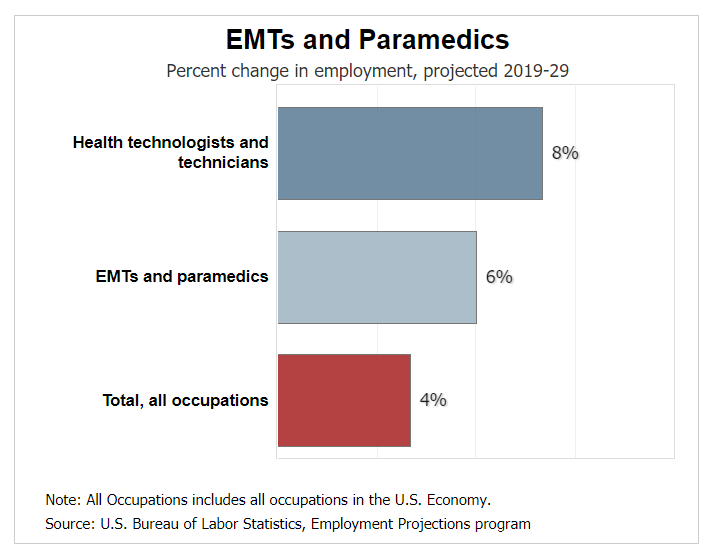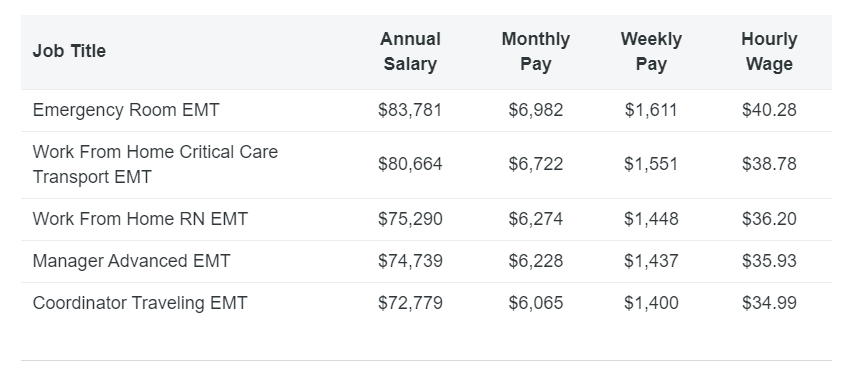Frequently Asked Questions About Becoming an EMT
Becoming an emergency medical technician (EMT) or a paramedic is an excellent career choice for people who are calm under pressure, like to be active, and want to help others. According to the US Bureau of Labor Statistics, the employment rate for jobs in Emergency medical services (EMS) is expected to grow by 6% from 2019 to 2029, making it one of the fastest-growing occupations today.

EMTs and paramedics are well-paid professionals. Data from Indeed shows that about 33% of EMTs in the US claim their salaries are enough to meet the cost of living in their locality. There are many opportunities to grow within the field, with those serving in emergency room settings often being the highest paid, earning roughly $84,000 annually.

If you are curious about how you can explore a career in emergency medical services, we’ve answered some frequently asked questions to get you started.
What is the difference between an EMT and a Paramedic?
Both EMTs and paramedics are emergency response professionals. The main difference is the level of education and the types of procedures they are qualified to perform.
EMT students complete a minimum of four months of training. They learn to assess patients to determine whether they have any life-threatening injuries or illnesses. An EMT training program gives individuals the necessary skills to perform services like cardiopulmonary resuscitation (CPR), glucose monitoring, and oxygen administration.
Paramedic courses, on the other hand, provide students with more extensive and intensive training, with programs spanning six to 12 months. The program includes a background in anatomy and physiology, pharmacology, cardiology, and medical procedures. Notably, paramedic subjects build upon the basic EMT training, and they may perform more complex procedures, including IV line insertion, drug administration, airway management, and pacemaker applications.
What are the steps to becoming an EMT?
Enrollment in an EMT training course does not usually require any previous medical background. However, some colleges do have prerequisites.
Step 1: Check your eligibility
Make sure you meet all the requirements for your school of choice. Most schools only require a high school diploma or proof of CPR training.
Step 2: Enroll in an EMT training course from a reputable school
Not all EMT schools on the internet are legitimate. Check their registration to confirm they are licensed to provide EMT training.
Step 3: Take the National Registry Exam
Once you’ve completed your EMT training, you’ll write the National Registry Exam. This should be done as soon after the completion of training as possible.
Step 4: Apply for Certification
Within two years of receiving a course completion certificate, prepare all documentary requirements and apply for certification.
How does one become a paramedic?
To be accepted into a paramedic course, students must have at least six months of experience working as an EMT. Some colleges also require their students to take college-level anatomy and physiology, show proof of immunizations, and pass a criminal background check.
How many hours do EMTs work?
Shifts are normally twelve hours, but it is not uncommon to work longer if an emergency worker is in the middle of a call. Urban areas do not necessarily have more calls, since there would be more responders on duty.
What can I expect from working as an EMT?
Being an EMT in the real world is very different than what is often seen on TV and in movies. Many calls are non-emergencies, as many people abuse the EMS system, such as drug seekers, individuals needing a ride home after a drinking spree, or someone needing a place to stay for the night. Emergencies are more common for those working in a 911 response setting.
What are the skills needed to become a successful EMT?
Being an EMT requires these essential skills:
Physical Endurance
EMTs are required to be physically healthy since it is a physically demanding job. There are instances when they are required to lift heavy objects or patients.
Emotional Agility
As first responders, EMTs often see people in tragic and emergency situations, and they must maintain their professional capacity to perform their duties. Working in such tense situations can lead to distress and burnout, so emotional fortitude is critical—as is the ability to recognize when mental support is needed.
Problem Solving Skills
The ability to think clearly and solve problems under pressure are important when emergency responders need to make life-saving decisions given limited information.
Communication Skills
During stressful events where concise information is critical to saving lives, being able to communicate effectively is critical.
Now that you know what goes on during EMT training and how to become a paramedic, are you ready to take on this role? Learn more about the different EMT programs from HCI.
If you plan to become a successful EMT, contact HCI College admissions to find out how you can earn a diploma.
If you found this information helpful, please share it on your social media channels.














